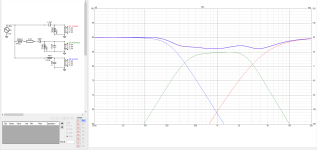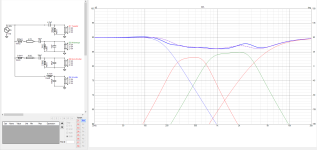I'm playing around with the simulation of converting 3-way speakers to 4-way. The original speakers are ADS L980/2.
Here is the simulation of original FILTERS' transfer function.

Assume I add a 6-Ohm cone mid-woofer to the system. Then, after tweaking the crossovers to meet the original filter's response, the result is here.

I have a question on it. Let's look at the Mid-Woofer's circuit, it can be seen that the low-pass filter's component values are larger than those of the high-pass filter e.g., 3.5mH versus 2.6mH, and 68uF versus 33uF. Will it cause any problems? Because I usually found the component values of high-pass filter are larger than those of the low-pass filter. Also, I'd like to request for the comments on this modification.
Here is the simulation of original FILTERS' transfer function.

Assume I add a 6-Ohm cone mid-woofer to the system. Then, after tweaking the crossovers to meet the original filter's response, the result is here.

I have a question on it. Let's look at the Mid-Woofer's circuit, it can be seen that the low-pass filter's component values are larger than those of the high-pass filter e.g., 3.5mH versus 2.6mH, and 68uF versus 33uF. Will it cause any problems? Because I usually found the component values of high-pass filter are larger than those of the low-pass filter. Also, I'd like to request for the comments on this modification.
Last edited:
@planet10
IMHO, it's not that easy as the goal is different. The conversion is motivated by the hypothesis that the original speakers, ADS L980/2, lack the mid-low frequency range. Resulted from the use of an only 2-inch dome midrange with a single 12" woofer and no mid-woofer driver there to do its task. By listening, I felt they really lack the mid-low range. The voice seems to be open and have excellent clarity, but I occasionally felt a lack of WARMTH. So, simply adding a subwoofer should not suffice. There's no issue with bass except for the low end of the human voice.
IMHO, it's not that easy as the goal is different. The conversion is motivated by the hypothesis that the original speakers, ADS L980/2, lack the mid-low frequency range. Resulted from the use of an only 2-inch dome midrange with a single 12" woofer and no mid-woofer driver there to do its task. By listening, I felt they really lack the mid-low range. The voice seems to be open and have excellent clarity, but I occasionally felt a lack of WARMTH. So, simply adding a subwoofer should not suffice. There's no issue with bass except for the low end of the human voice.
Well, my friend advised me not to be worried about the comparison of component values between high-pass and low-pass filters as the result, the frequency response, could still perfectly match the original response. In addition, if the impedance curve does not fluctuate or fall too low, there should be no concern. Is this correct?
160-320Hz, is it too narrow bandwidth? Will it difficult to design a crossover not to interfere each other, the high- and low-pass section of the bandpass filter?Better ahead starting from scratch usig the bits you have? Low-Mids 160>320 Hz.
My plan is to cut some duties on both dome midrange and woofer, and transfer them to the cone mid-woofer. As can be seen in the original post, the midrange is shortened its low-end from 350 to 700Hz, as well as the woofer that is moved from 350 to approximately 270Hz.
Applying electronic simulation is good, but in my opinion has limited benefits when adding a whole new device into the speaker, with 2 new crossover and phase points with the existing drivers.to meet the original filter's response
With speakers I think less is often more. I'm not talking about the 'single capacitor filter for tweeters' type 'less is more', fashionable a few years ago for generating huge amounts of IM distortion from over excursed soft domes, I'm talking about less flapping bits of cardboard and plastic, that need to try to mix with other flapping bits of paper and plastic.
Perhaps there's a good reason for some 2 way and even 3 way speakers, but the further you move from a coherent single point, the more physics fights you. This is why it's generally wise to pick crossover points outside of the human 'super sensitive' range of speech, manufacturers who dump their crossovers at 3kHz or so are missing a trick - perhaps that's one benefit of a 3 way - to get rid of crossover artifacts from that midrange.
So I would suggest trying to get a (mounted) frequency plot of your drivers, maybe with a sig-gen, piece of paper and a phone app dB meter, and then adapt the crossover for better sound. Crossovers are very important, perhaps the one in your speaker needs optimising.
Well, the easiest way of knowing whether the speakers lack output at the bottom end of the midrange is by measuring their response. Then you don't need to hypotheise: you'll know for a fact. Thing is, this business of using resistors for simulations is almost useless as you've no idea what the actual on-baffle frequency response of the drivers is, nor their frequency-varying impedance loads which can completely alter the necessary component values and / or overall filter configuration.IMHO, it's not that easy as the goal is different. The conversion is motivated by the hypothesis that the original speakers, ADS L980/2, lack the mid-low frequency range.
Which is fine -but it's also speculation as you don't know whether it's 'just' a case of your own personal preference, or something inherent to the speaker, and if it's the latter, what the cause is.By listening, I felt they really lack the mid-low range. The voice seems to be open and have excellent clarity, but I occasionally felt a lack of WARMTH.
First simulate the filter with this value.
The idea is to increase the level in the mid-low frequency range where you say you would like more. I don't realize how big the woofer is, but it can certainly go higher in frequency and I don't see any reason for it to be electrically cut so low.
The idea is to increase the level in the mid-low frequency range where you say you would like more. I don't realize how big the woofer is, but it can certainly go higher in frequency and I don't see any reason for it to be electrically cut so low.
- Home
- Loudspeakers
- Multi-Way
- Converting 3-way to 4-way
